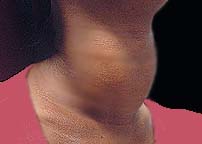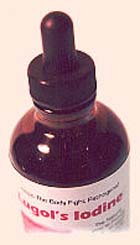Goi·ter ("goy-ter") n. French goitre, from Middle French, back-formation from goitron throat, from (assumed) Vulgar Latin guttrion-, guttrio, from Latin guttur d.1625: an enlargement of the thyroid gland visible as a swelling of the front of the neck--compare Hyperthyroidism, Hypothyroidism, goi·trous, adj.
Merriam-Webster Dictionary
Statistics:
 A normal adult thyroid gland weighs 10-25 grams, with 2 lobes connected by an isthmus
A normal adult thyroid gland weighs 10-25 grams, with 2 lobes connected by an isthmus
 Almost 50% of thyroid glands exhibit a pyramidal lobe arising from the center of the isthmus
Almost 50% of thyroid glands exhibit a pyramidal lobe arising from the center of the isthmus
 The female-to-male ratio of individuals with goiters is 4.1.
The female-to-male ratio of individuals with goiters is 4.1.
 It is estimated that 1 in 12 women vs. 1 in 50 men, has a thyroid nodule.
It is estimated that 1 in 12 women vs. 1 in 50 men, has a thyroid nodule.
 3% of men older than 60 years of age had thyroid nodules.
3% of men older than 60 years of age had thyroid nodules.
 36% of women between the ages of 49-58 years had thyroid nodules.
36% of women between the ages of 49-58 years had thyroid nodules.
 Of approximately 750 million people normally exposed to an iodine-deficient diet, as many as 1/4th of those have goiters.
Of approximately 750 million people normally exposed to an iodine-deficient diet, as many as 1/4th of those have goiters.
 Although thyroid nodules are found less frequently in male patients than in females, once they are found, they are more likely to be malignant.
Although thyroid nodules are found less frequently in male patients than in females, once they are found, they are more likely to be malignant.
Helpful Links:
Goiter
goiter is an enlargement of the thyroid gland that is not associated with inflammation or cancer. A simple goiter begins when the thyroid gland is not able to produce enough thyroid hormone to meet the needs of the body. This is called hypothyroidism. Symptoms often include tenderness to the touch, pressure against the esophagus, coughing or wheezing, hoarseness, shortness of breath, choking or shortness of breath at night, weight gain, depression, fatigue, or a feeling that food is getting stuck in the throat.
 Thyroid nodules are very common. A nodule is a swelling or lump, which can be a solid or liquid filled cyst or mass. Most are benign (around 90%), but a small percentage can be malignant. Symptoms of thyroid nodules include palpitations, insomnia, weight loss, anxiety, and tremors. These are common in hyperthyroidism.
Thyroid nodules are very common. A nodule is a swelling or lump, which can be a solid or liquid filled cyst or mass. Most are benign (around 90%), but a small percentage can be malignant. Symptoms of thyroid nodules include palpitations, insomnia, weight loss, anxiety, and tremors. These are common in hyperthyroidism.
 The thyroid can grow to be quite large so that it is visible in the neck. Many factors may contribute to the thyroid enlargement, but the main cause seems to be due to an increase in thyroid stimulating hormone (TSH). TSH comes from the pituitary gland and over a number of years, causes the thyroid to enlarge. Another cause of goiters is a diet deficient in iodine, although this is rare today due to the availability of iodine in our foods.
The thyroid can grow to be quite large so that it is visible in the neck. Many factors may contribute to the thyroid enlargement, but the main cause seems to be due to an increase in thyroid stimulating hormone (TSH). TSH comes from the pituitary gland and over a number of years, causes the thyroid to enlarge. Another cause of goiters is a diet deficient in iodine, although this is rare today due to the availability of iodine in our foods.
 Goiters are often removed surgically when the glands are enlarged enough to affect breathing and swallowing, or if there are indications of malignancy, however, the incidence of malignancy is usually less than 5%, and for cosmetic reasons.
Goiters are often removed surgically when the glands are enlarged enough to affect breathing and swallowing, or if there are indications of malignancy, however, the incidence of malignancy is usually less than 5%, and for cosmetic reasons.
 Thyroid cells are the only ones in the body capable of absorbing iodine, an important mineral nutrient and potent germ killer. We know from clinical study that few people have anywhere near enough iodine in their body for the thyroid to function optimally.
Lugol's Iodine, first developed in 1829, is an effective bactericide and fungicide, consisting of 10 parts potassium iodide to 5 parts iodine to 85 parts of (distilled) water, and may help the body replenish its supply of this necessary nutrient.
Thyroid cells are the only ones in the body capable of absorbing iodine, an important mineral nutrient and potent germ killer. We know from clinical study that few people have anywhere near enough iodine in their body for the thyroid to function optimally.
Lugol's Iodine, first developed in 1829, is an effective bactericide and fungicide, consisting of 10 parts potassium iodide to 5 parts iodine to 85 parts of (distilled) water, and may help the body replenish its supply of this necessary nutrient.
 Note:
This information is provided for educational purposes only and is not
intended to replace the use of a qualified health care professional. We
strongly recommend the use of a physician for the diagnostic phase of any
treatment. With an accurate diagnosis in hand, we believe the consumer, at
that point, has a basic, unalienable right to seek out factual information
on all therapeutic approaches, both orthodox and alternative, and choose
those approach(es) that are right for them. Nonetheless, a "good doctor"
should be considered a requisite starting point.
Note:
This information is provided for educational purposes only and is not
intended to replace the use of a qualified health care professional. We
strongly recommend the use of a physician for the diagnostic phase of any
treatment. With an accurate diagnosis in hand, we believe the consumer, at
that point, has a basic, unalienable right to seek out factual information
on all therapeutic approaches, both orthodox and alternative, and choose
those approach(es) that are right for them. Nonetheless, a "good doctor"
should be considered a requisite starting point.

 To U.S.
Users: None of the products mentioned on this page have been evaluated
by the U.S. Food & Drug Administration; therefore, they are not
intended to diagnose, treat, cure, or prevent any disease.
To U.S.
Users: None of the products mentioned on this page have been evaluated
by the U.S. Food & Drug Administration; therefore, they are not
intended to diagnose, treat, cure, or prevent any disease.
